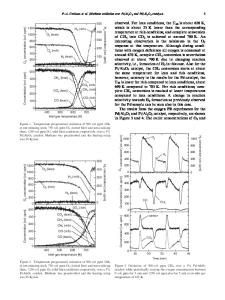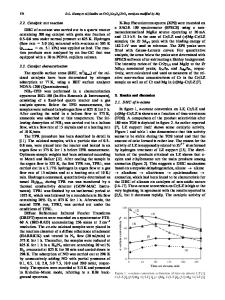Surface Characterization of W/Ni/Al 2 O 3 Catalysts
- PDF / 338,430 Bytes
- 6 Pages / 414.72 x 648 pts Page_size
- 41 Downloads / 335 Views
M.H. Jordio *,J.M. Assaf, P.A.P. Nascente ** *Departamento de Engenharia Quimica, Universidade Federal de SAo Carlos, 13565-905 Slo Carlos, SP, Brazil, [email protected] **Centro de Caracteriza9lo e Desenvolvimento de Materiais, Departamento de Engenharia de Materiais, Universidade Federal de Sio Carlos, 13565-905 Slo Carlos, SP, Brazil, [email protected] ABSTRACT Catalysts containing tungsten and nickel oxides are important in hydrodesulfurization (HDS), hydrogenation (HY), and steam reforming of hydrocarbons. A series of W/Ni/AI 20 3catalysts was prepared by two different methods: (1) coprecipitation of nickel and aluminium hydroxicarbonate from their nitrates, followed by calcination and impregnation of tungsten; (2) precipitation of boehmite from aluminium nitrate, followed by impregnations of nickel, firstly, and tungsten. The nickel content was kept constant, while the amount of tungsten varied from 2.5 to 15.5 wt-%. The resulting oxides were characterized by inductively coupled plasma spectroscopy (ICP), atomic absorption spectroscopy (AAS), X-ray diffraction (XRD), temperature programmed reduction (TPR), and X-ray photoelectron spectroscopy (XPS). ICP and AAS were used to determine the W, Ni, and Al concentrations. XRD detected two phases: NiO and NiA120 4 (no phase containing metallic tungsten was detected). Increasing the amount of W, the quantity of NiAl20 4 rose, the quantity of NiO decreased, and the particle size of NiO enlarged. The TPR profiles presented three peaks: one at about 1000 TC, associated to a very stable phase; for the samples prepared by coprecipitation, the other two peaks corresponded to "free NiO" and a nonstoichiometric aluminate. For the samples prepared by impregnation, those peaks corresponded to NiO and NiAl 20 4. XPS identified A120 3, NiA120 4, and A12(WO 4)3 for both preparation methods. Increasing the amount of tungsten in the impregnated samples, NiWO 4was also observed. INTRODUCTION Catalysts of nickel supported on alumina are applied to several industrial chemical reactions, such as hydrogenation and steam reforming of hydrocarbons. Catalysts of tungsten supported on alumina are also employed in hydrogenation reactions [1, 2], although nowadays their main application is in hydrodesulfurization [3, 4]. In this case, sulfated W-based catalysts are used [5, 6]. Catalysts of nickel supported on alumina with the addition of tungsten and alkaline metals as promoters have been studied in steam reforming of hydrocarbons, in which tungsten plays a fundamental role in the selectivity of some reactions [7-9]. In this work we have investigated the influence of tungsten on catalysts of nickel supported on alumina prepared by two methods: (1) coprecipitation of nickel and aluminium hydroxicarbonates from their nitrates, followed by calcination and impregnation of tungsten; (2) precipitation of aluminium hydroxide (boehmite) from its nitrate, followed by calcination and impregnations of nickel, firstly, and tungsten. The nickel content was kept constant, while the amount of tun
Data Loading...











